Overview
Did you think getting a fish would be a low-maintenance emotional support for you as compared to demanding pets like cats/dogs? And now, here you are, researching how to clean the sand of the fish tank.
That’s completely fine! These beautiful creatures are worth all the hassle for the therapeutic and restorative experience they bring to your life.
Dwell into the article and learn about different ways you can clean aquarium gravel/sand, the steps you need to take, and the tips you need to consider. Scroll down!
How To Clean Aquarium Sand Before Use?

First off, if you have an old fish tank and renewing the fine sand substrate in it, you might as well clean the aquarium. Use fish scrappers to take out the substrate and rinse the tank properly. The next step is getting the aquarium sand ready to welcome your new fish friend.
You can find tons of great sand options out there for your aquarium. However, to ensure the sand you got won’t turn the water muddy and cloudy, it’s essential to clean it before putting it in the water tank. The two common methods to clean fish tank sand before use are the following:
Faucet and Sink Method
One of the easiest ways to clean dirty sand, accessible to almost every household, is the faucet and sink method. Its working principle is the same as you would use to rinse-clean the rice. The first thing you need to do is empty the sand into a bucket. Then pour fresh water into the bucket.
We recommend making a volcano-type hole at the bottom of the sand for the water to reach evenly, not leaving anything dry.
Stir the sand using your hand or any tool, and then rinse off the water in the sink. Repeat this at least thrice until you feel the water is clean. There you go with the easiest way to clean your aquarium sand.
Garden Hose Method
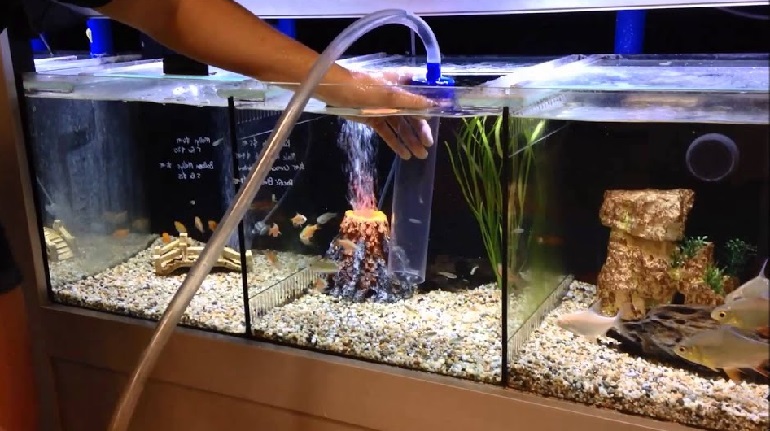
A garden hose is an effective tool that does the job of a siphon tube for you. It is a more straightforward way to clean the sand than the faucet and sink method.
The first step is the same: pour the sand into a large container and add fresh water. Overflow the inside of the container/bucket with the hose in a way the sand is agitated. Let it happen until the dirty water is gone
How To Clean Aquarium Sand With a Siphon?
Siphon is a necessity for every fish owner to have in hand for fish tank regular maintenance and regular water changes. And if you’re new to the fish pet world, you might ask, what exactly is a siphon?
Well, the siphon or a gravel vacuum is an effective tool to eliminate fish waste, debris, food waste, plant waste, and dirt buildup on the gravel. It is also helpful for changing the water of the fish tank.
Aquarium siphons can be found in different sizes and designs, all ultimately serving the same purpose. You will need to get one according to your needs, like the size of your fish tanks, the number of fish, and the number of plants. How to siphon a fish tank would be the next question in your mind, and here’s how:
- Firstly, you need to take the top of the siphon/gravel vacuum, which looks like a tube and dip it inside the tank to fill it with water. Make sure to fill it out completely with water.
- The next thing you ought to do is cover the bottom of the hose with your thumb. Hold the tube straight, and take it as high as possible.
- Keep holding it till you see the bubble formation, as those bubbles will be responsible for the suction.
- The tube should be half empty by now. Immerse it again inside the tank while letting the end of the hose loose(by no longer placing the thumb on it) into the bucket simultaneously, creating the suction.
- Now roll the tube over downwards, and press it against the rock bed. This will instigate the procedure of vacuuming your fish tank. And while doing this, the tube will also suck rocks. Shake the tube to get those all out, so to prevent the blockage of the hose.
- Keep doing it until you’re sure all the sand surface is cleaned. And that’s how to clean aquarium sand with a siphon gravel vacuum.
Siphon is also used to change the water in the fish tank. Don’t forget to use a water conditioner while changing the water in the tank. Because if you directly let the tap water in, it will be akin to deliberately contaminating the tank water quality and ruining the clean sand.
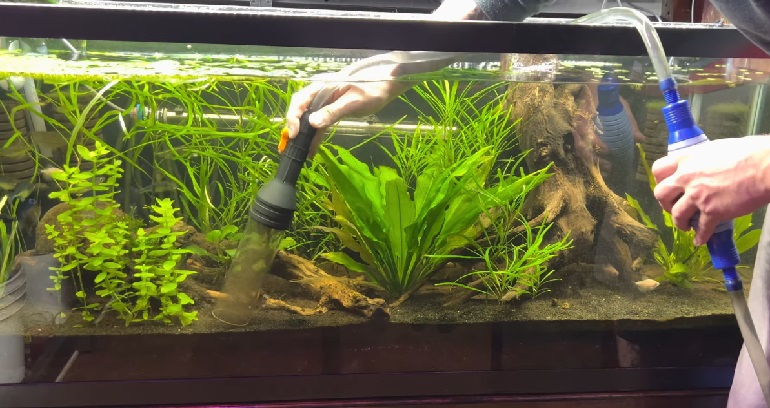
Using Sand Cleaning Fish To Clean Your Fish Tank Sand
Ever heard of fish that could be used to clean the fish tank sand? No worries, we’re about to turn a novice fish owner into a pro.
There are certain fishes that serve the function of cleaning aquarium sand. Introducing these types of fish to the aquarium keeps the tank clean, safe from harmful bacteria, and keeps it healthy for longer.
However, it doesn’t mean you won’t have to play a part in maintaining the quality of fish tank water and sand. Sand Cleaning fish will do their part, and you will do yours.
Let’s talk about the most common Sand Cleaning fishes used by fish owners and recommended by Aquarists.
Corydoras
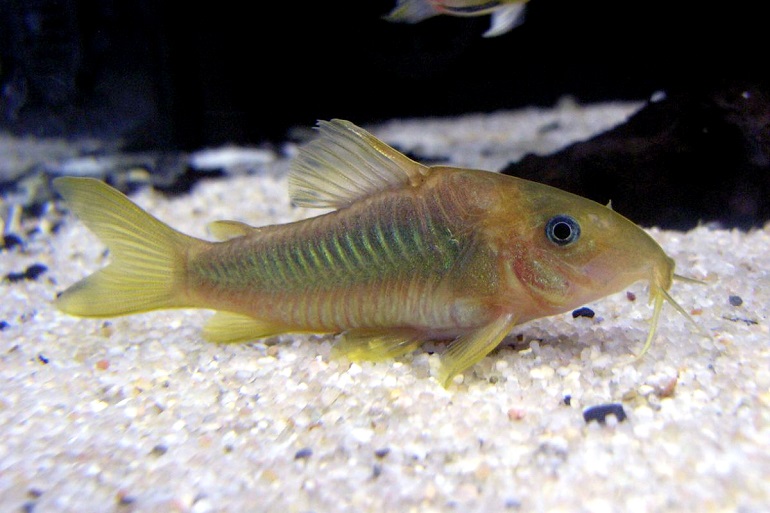
Fishes don’t put their food leftovers in the fridge to microwave later; it gets left in clean water. Uneaten fish food can decompose into nitrate and ammonia, clogging the filter, affecting its efficiency, and lowering the PH level of water inside the tank. Which in turn becomes the abode for mold and fungus.
To avoid this, introduce the Corydoras fish into the pond. Corydoras is a type of catfish that works efficiently to keep the aquarium tank clean; truly a hard worker.
They could work as detectives, for the skill they have to look up for any last morsel of food. Corydoras belongs to the Almond catfish with various fish species. You will need four or five of these in your tank.
This catfish continuously digs and root through sand/gravel in search of any sign of food particles. While doing that, these fish stir up the dirt, aiding the filter to pick it up and thus significantly contributing to keeping the sand clean, aquarium too.
Loaches
Loaches are a type of scaled fish belonging to the superfamily Cobitoeda. Loaches work on a similar principle as Corydoras; they also root at the bed of the fish water tank and try to dislodge any trapped food particles, thus keeping the outer layer of substrate/gravel cleaner.
However, they aren’t essentially catfishing like the Corydoras.
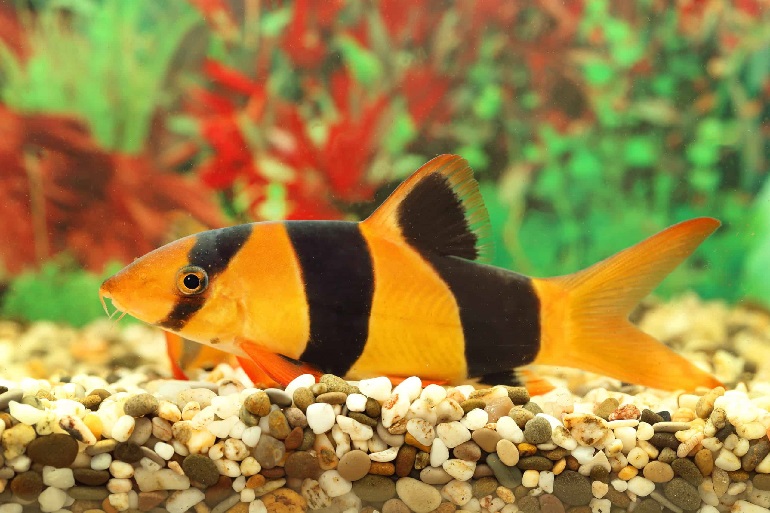
Loaches tend to grow much bigger in size. The largest size of the loach that you can find will be the Clown Loach.
It is a tropical freshwater fish that can grow up to about one foot in length. Indicating that you will need a bigger aquarium to keep them functioning properly. The smaller congested aquarium will stress these out.
Moreover, Loaches are fast swimmers and move in an agile manner. They like to stay together in groups to wipe out any trace of uneaten food.
Geophagus
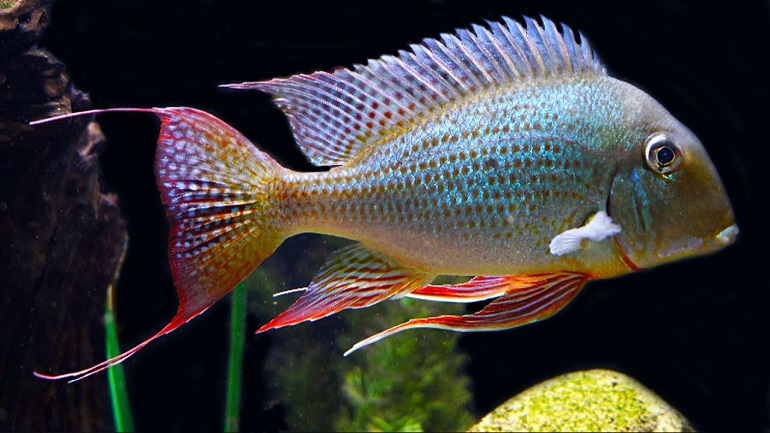
Sand-cleaning Geophagus is totally different from the above species. Its name Geophagus means earth eater, which in turn reveals the method they use to eliminate any trace of uneaten food.
What they do is pick up a chunk of sand and gravel in their mouth and then filter it out of any food present. This makes them ideal because the sand/gravel is turned over properly, and thorough cleaning of the aquarium sand is ensured.
Aquarium sand is preferred as a substrate if you intend on introducing Geophagus to the aquarium. Why?
Because of the chunks they take into their mouth, gravel can cause clogging in their mouth or gills. It’s best to keep them in adequately/large-sized tanks, preferably with the fish species belonging to their habitat region, Central or South America.
There are a lot of species available of Geophagus. They tend to be more expensive than Corydoras catfish and Loaches, but the money is worth it for how well they do their job. Not to mention how spectacular they look, even when they grow old.
Why Should You Clean Your Aquarium Sand?
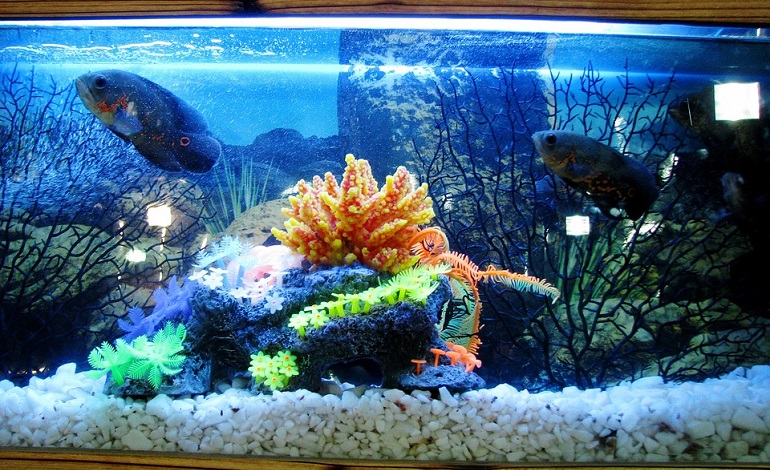
This shouldn’t be a question in the first place. Nonetheless, to grasp the gravity of why you should clean the sand, we’ve listed important aspects of it.
As a fish parent, it’s your responsibility to provide a safe, clean, and comfortable living environment for your fish. And this all can’t happen if you don’t clean the aquarium sand.
To Prevent a Build-Up of Toxins and Bacteria
Fish tanks, when left unclean for an extended period, become the abode for harmful bacteria, fungi, and viruses that can be detrimental to the health of your water resistant.
Besides, dirty water in the tank due to uncleaned sand lowers the pH in the fish tank, resulting in the emission of gases unsuitable for optimal living conditions.
To Keep Your Plants Healthy

Plants also require certain settings for proper growth. The debris of uneaten food and fish waste can increase the levels of nitrate and phosphorus in the water. And when this happens, it can result in the stunted growth of the plants, as nitrate levels, if too high, negatively affect the growth of live plants.
Also, make sure your aquarium is getting adequate sunlight/light. Nothing can beat the natural light source to keep the plants happy and healthy.
To Make Sure Your Fish Stay Healthy
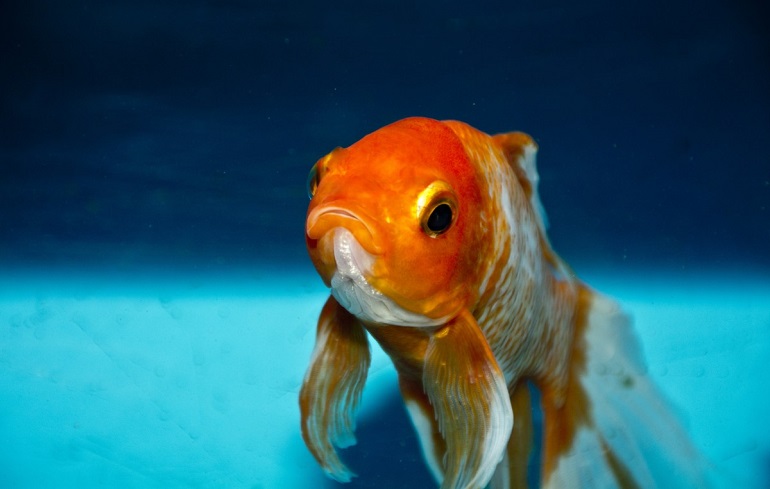
The state of the aquarium directly impacts the health of your fish. It’s their abode, so it’s obviously going to be the determinant of their overall well-being. So, it’s important to maintain it.
The imbalance of the pH level of the water inside the tank lowers your fish’s ability to swim, eat and reproduce properly.
If you start noticing signs like your fish frequently bumping into the walls, going in hiding for an extended period, not eating properly, or gasping for air on the surface, etc., a dirty fish tank is very likely to be the reason for all the distress. Thus, don’t undermine the importance of cleaning it.
Besides, getting crystal clear aquarium water will not only be beneficial for your fish, but it also looks visually appealing.
The Cleaning Process

When you’re going for a thorough clean-up of the tank, you will have to devote a significant part of the day to it. This shouldn’t be a problem if you love your aquarium and its beautiful residents.
Clean the Inside of the Tank
The cleaning process step can vary with how frequently you have been cleaning the aquarium sand.
Generally, you need to examine the quality of water. Does it feel dirty/polluted? Start with cleaning the inside of the aquarium. To get started with that, get rid of all the algae. It’s better to get all the decorations off to ensure thorough cleaning.
Once you’re done with that, take a lint-free cloth/sponge and clean the walls of the aquarium properly. Put the cleaned decorations back in the tank. Followed by letting the fish in.
Rake Up the Aquarium Sand
Raking up the sand is vital to ensure a smooth cleaning process. The compacting of sand is likely to happen with time, which can result in causing hindrance to the filtration process. All you need to do is use the sand rake to loosen the sand particles up.
Use a Gravel Siphon
Gravel siphon, as we discussed earlier, is an amazing tool to get rid of all fecal waste, food debris, dirt, or plant waste trapped inside the gravel/sand substrate. It sucks out all the potentially contaminating particles and cleans the aquarium sand.
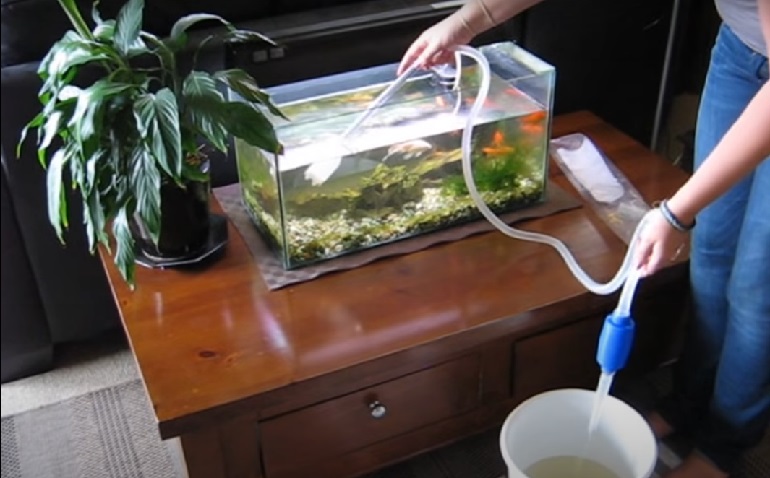
Refill the Tank
The water in the fish tank is likely to decline in amount, requiring you to refill it. You can use a garden hose for quick refilling.
Turning off lights before doing that will prevent any kind of hazard from happening, and removing decorations will ensure a clean transfer. Turn back the lights on, put back the gravel/sand, and your preferred tank décor. Welcome your water friend into the Aquarium!
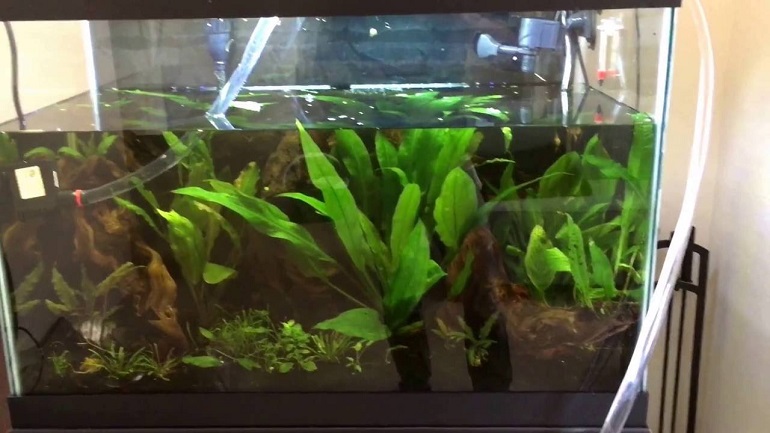
Helpful Tips To Keep Your Aquarium Sand Clean
Below are a few tips that can be useful in keeping your aquarium sand clean.
Reintroduce Aquarium Sand
If you have used a certain type of gravel for too long, it might be time to shift to new sand. Or even if you were using the sand, get another type.
Reintroduce a thin layer of aquarium sand/gravel that best matches the essence of your fish’s natural habitat, is easier to clean( like coral sand), and offers great visuals. Reintroducing sand in the saltwater aquarium acts as a stabilizing agent, creating a healthy, happy environment for your fish.
Introduce Snails in the Tanks
One of the tremendous things you can do to keep your aquarium clean is introducing Nassarius snails into the tank. How will that be of help?
Well, snails are recognized for being ‘detritivores.’ Nassarius snails are the sand sifters that gobble upon any uneaten food, fish waste, or decaying plants, leaving you with clean aquarium sand and, thus, the tank. They also clear up excessive algae in the tank.
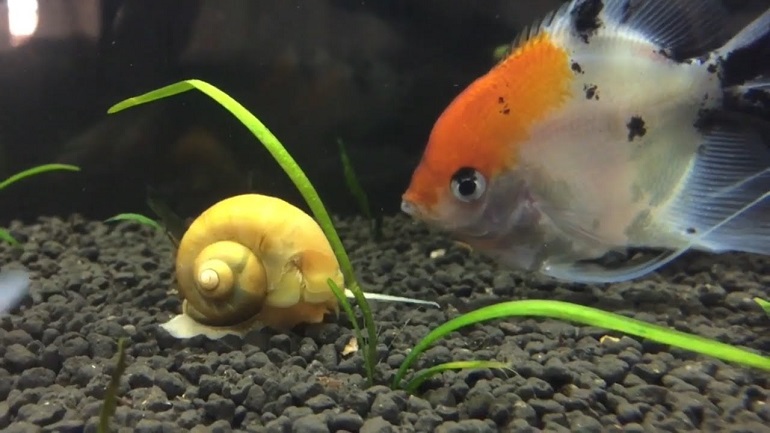
Although don’t add too many crew members to the cleaning force of snails at once; that’s probably not a good idea. Too many snails in the fish tank can lead to overconsumption of oxygen levels and nutritional imbalance, and the tank becomes overcrowded. So introduce an adequate number of snails.
Frequently Asked Questions
How to clean saltwater aquarium sand?
To maintain the good condition of the fish tank, cleaning saltwater aquarium sand is an absolute necessity. You will need to devote at least one hour every two weeks. To clean your saltwater aquarium, you will have to clean algae, and you can use regular algae brush for that.How To Clean Saltwater Aquarium Sand?
Then change the water using gravel or sand siphoning to get rid of any debris built up at the sand bed. If you don’t want to shock the balance of the aquarium, go for filtration one week, followed by a water change the next week.
How To Clean Black Aquarium Sand?
Cleaning black aquarium sand is not much different than normal sand. Don’t let the color puzzle you.
Once you get the black sand, run over the metal detector to detect any presence of metal. Empty the black sandbox in the bucket and put it under a running tap for about 15-20 minutes. You will need to stir the sand after a few minutes during the water overflow.
Stop once the tap water runs clear. Rinse off the extra water, and it’s good to go in the fish tank.
Should I Clean My Aquarium Sand?
Yes, you should definitely clean your aquarium sand. Wash/rinse sand properly before introducing it to the tank. Frequently cleaning the fish tank sand at least every two weeks will reduce the future workload of cleaning the aquarium.
It is essential to clean aquarium sand to maintain optimal living conditions and good health for your fish and ensure proper plant growth in the tank.
Conclusion
If you have read this article to the very end, we hope we have sorted out all your queries. Best of luck if you are getting a fish or trying hard to care for your existing water friend.
Remember, you can’t afford to procrastinate in cleaning aquarium sand. You don’t want those precious creatures to die, do you?












